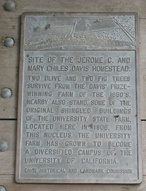Jerome C. Davis [1822-1881] was born on a family farm in Perry County, Ohio to Isaac Davis and Rachael Manley in 1822. He had a brother, Franklin B., and a sister, Elnora. As a young man Jerome lived in Ohio.
In 1845, at the age of 23, he enlisted in John C. Fremont's survey expedition and first arrived in California with the group around December 1845. His name appears in the National Archives on a Muster Roll for Captain Richard Owen's Company A of the Mounted Rifleman — it indicates that Davis enlisted as a Private on October 7, 1846, at Cosumne (Sacramento County) and mustered out of his unit on December 7, 1846. He later was summoned to testify at Fremont's court martial, along with Joseph B. Chiles. After a stay in St. Louis, Davis again set out for California in the spring of 1849 accompanied by nine other men. He briefly tried his hand at mining, but returned to Sacramento to capitalize on the Gold Rush in other ways.
These other ways led him to establish Yolo County's first dairy and, in partnership with the Joseph B. Chiles, Jerome operated a rope ferry across the Sacramento River. With inflationary rates spurred by the Gold Rush, his milk sold for $1/gallon and ferry tolls would often net $10,000/month. Around this time, Jerome began courting Joseph B. Chiles' daughter, Mary Chiles, who lived across the American River on the north bank — the round trip visits cost Jerome $16 each time. But his efforts paid off and the two were married in early 1850, living on the Chiles' 360 acre ranch for a brief period of time. The 1850 census for Washington Township (West Sacramento) describes him as a 27-year-old dairyman from Ohio, and his wife, Mary A. Chiles Davis, as a 15-year-old native of Missouri.
By 1852 Jerome had relinquished his share of the ferry business and lost the dairy to severe flooding, prompting the couple to relocate to the north bank of Putah Creek on land recently purchased by Colonel Chiles. On June 18, 1852 Amelia Susanna Davis was born and Jerome's parents came to live with the family in California; Jerome's sister and brother-in-law, Elnora and Joseph Mitchell, along with their daughter immigrated to California, as well. Joshua B. Tufts, a shirt-tail relative of Jerome's, lived on the south bank of Putah Creek.
Jerome's father Isaac was instrumental in helping expand Jerome's farm ranch, and by 1858 Jerome owned 12,000 acres of grazing and crop lands, 2000 head of cattle, 250 dairy cows, 210 horses and mules, 600 sheep and 150 hogs. In that same year, 1858, he received a silver trophy of excellence indicating a first-class rating from the California State Agricultural Society, and later served as president of that society from 1861 to 1863. Despite the success of the family ranching operation, tragedy struck the Davis family, when their only child, Amelia, died at the age of three from injuries she received while playing at the mill. She fell from a moving belt while playing games with her adoring father — the mill was immediately dismantled and Amelia buried in Sacramento, her grave marked by a sleeping lamb of white marble.
 Site marker next to Olson Hall
Site marker next to Olson Hall
By 1863, drought, crop failures and high taxes and interest all conspired to make maintaining the business difficult. Jerome initially transferred 7,000 acres of ranch land to his father, and by 1866 deeded his father the entire ranch before settling with his wife on N Street in Sacramento. In November 1867, Isaac Davis mortgaged the southern part of his ranch to the California Pacific Railroad line and Davisville was born November 28, 1868; the former home of Jerome C. Davis became a hotel known as the Yolo House. 778 acres of the original ranch later formed the basis for the University Farm, now recognized as UC Davis.
Jerome's retirement from the farm created a new passion for civic affairs. It was during this time that he successfully ran on a Republican ticket as the second Trustee of the City of Sacramento in 1880. He was a member of Tehama Lodge No. 3, F&AM, Sacramento Council No. 1 and Sacramento Commandery, No. 2, Knights Templars. He also served as Sacramento Street Commissioner until his death on October 5, 1881 — he preceded Mary in death by 34 years. She passed away on January 14, 1915 as was buried alongside her husband in the Davis family plot in Sacramento.
Other Notes
Isaac Davis also served as as president of the State Agricultural Society in 1863 in California. He was elected as County Judge in Yolo County, California. He served as as associate judge of the Court of Sessions in Davis, Yolo County, California. He served as as a grand officer of all Masonic bodies in the state in California. He served as as grand master of Sacramento Masonic Lodge #2 in Sacramento, Sacramento County, California.
To learn more about Davis history, please visit our pages of Historic Places, Town History and Davis Timeline.




